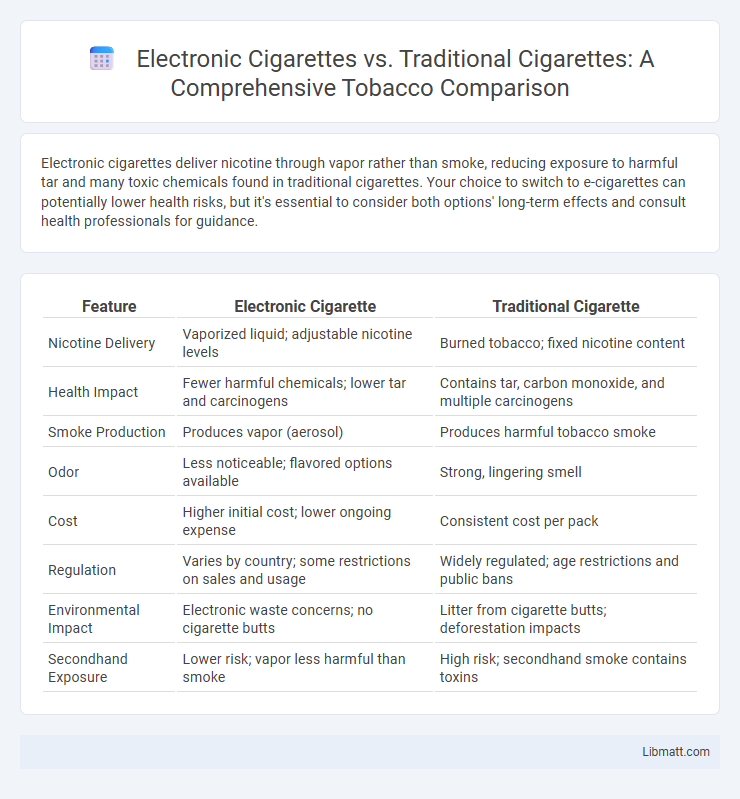Electronic cigarettes deliver nicotine through vapor rather than smoke, reducing exposure to harmful tar and many toxic chemicals found in traditional cigarettes. Your choice to switch to e-cigarettes can potentially lower health risks, but it's essential to consider both options' long-term effects and consult health professionals for guidance.
Table of Comparison
| Feature | Electronic Cigarette | Traditional Cigarette |
|---|---|---|
| Nicotine Delivery | Vaporized liquid; adjustable nicotine levels | Burned tobacco; fixed nicotine content |
| Health Impact | Fewer harmful chemicals; lower tar and carcinogens | Contains tar, carbon monoxide, and multiple carcinogens |
| Smoke Production | Produces vapor (aerosol) | Produces harmful tobacco smoke |
| Odor | Less noticeable; flavored options available | Strong, lingering smell |
| Cost | Higher initial cost; lower ongoing expense | Consistent cost per pack |
| Regulation | Varies by country; some restrictions on sales and usage | Widely regulated; age restrictions and public bans |
| Environmental Impact | Electronic waste concerns; no cigarette butts | Litter from cigarette butts; deforestation impacts |
| Secondhand Exposure | Lower risk; vapor less harmful than smoke | High risk; secondhand smoke contains toxins |
Introduction to Electronic and Traditional Cigarettes
Electronic cigarettes, also known as e-cigarettes or vapes, are battery-operated devices that vaporize a liquid solution containing nicotine, flavorings, and other chemicals, offering an alternative to traditional smoking. Traditional cigarettes burn tobacco, producing smoke that contains tar, carbon monoxide, and thousands of harmful chemicals linked to serious health risks such as cancer and cardiovascular disease. E-cigarettes aim to reduce exposure to toxic substances found in combustible cigarettes, but their long-term health effects remain under study.
Key Differences in Design and Composition
Electronic cigarettes feature a battery-powered heating element that vaporizes a liquid containing nicotine, flavorings, and other chemicals, whereas traditional cigarettes rely on combustion to burn tobacco wrapped in paper. The composition of e-cigarette liquid primarily includes propylene glycol, vegetable glycerin, nicotine, and flavorings, contrasting with the complex mix of tar, carbon monoxide, and thousands of harmful chemicals produced by burning tobacco in traditional cigarettes. Your choice between these smoking options affects the exposure to different harmful substances and the delivery method of nicotine.
Health Risks: Comparing E-Cigarettes and Traditional Cigarettes
E-cigarettes deliver nicotine through vapor without burning tobacco, significantly reducing exposure to harmful tar and many carcinogens found in traditional cigarettes. Despite this, e-cigarettes still pose health risks, including potential lung damage, nicotine addiction, and exposure to toxic chemicals like formaldehyde and acrolein. Traditional cigarettes cause higher rates of respiratory diseases, cardiovascular problems, and cancer due to the combustion of tobacco, which produces thousands of harmful substances.
Nicotine Delivery and Addiction Potential
Electronic cigarettes deliver nicotine through aerosolized liquid, allowing for rapid absorption similar to traditional cigarettes but with adjustable nicotine concentrations. Traditional cigarettes combust tobacco, releasing nicotine alongside numerous harmful chemicals, which intensifies addiction potential due to the combined sensory and chemical stimuli. Research indicates that while both forms can sustain nicotine dependence, the customizable nicotine levels in e-cigarettes might influence addiction severity and user behavior differently.
Chemical Exposure: Vapors vs. Smoke
Electronic cigarettes expose you to vapor containing fewer harmful chemicals compared to the smoke from traditional cigarettes, which contains thousands of toxic compounds including tar and carbon monoxide. Studies indicate that vaping significantly reduces exposure to carcinogens and other hazardous substances linked to lung disease and cancer. However, electronic cigarette vapor still contains nicotine and some harmful chemicals, so it is not entirely risk-free.
Social Perception and Acceptance
Electronic cigarettes are increasingly perceived as socially acceptable alternatives to traditional cigarettes due to their reduced odor and perceived lower health risks, especially among younger adults and tech-savvy demographics. Traditional cigarettes continue to face declining social acceptance driven by widespread awareness of their health hazards, stringent public smoking bans, and growing anti-smoking campaigns. Studies indicate that electronic cigarette use is often viewed as a socially tolerant behavior in public spaces where traditional smoking is prohibited, influencing marketplace trends in nicotine consumption.
Environmental Impact of E-Cigarettes and Cigarettes
Electronic cigarettes generate less environmental pollution than traditional cigarettes due to the absence of tobacco combustion, reducing air pollutants and toxic chemicals. However, e-cigarette waste, including lithium-ion batteries, plastic cartridges, and electronic components, poses significant challenges for disposal and recycling. In comparison, traditional cigarette butts contribute an estimated 4.5 trillion pieces of non-biodegradable litter annually, releasing harmful toxins into soil and waterways.
Regulation and Age Restrictions
Electronic cigarettes and traditional cigarettes are both subject to strict regulation and age restrictions to protect public health. Most countries enforce age limits, commonly 18 or 21 years, prohibiting minors from purchasing either product to reduce youth nicotine addiction. Understanding these legal frameworks helps ensure compliance with the law and promotes your safety when choosing between vaping and smoking.
Cost Comparison: Which Is More Affordable?
Electronic cigarettes typically have a higher initial investment due to the cost of devices and rechargeable batteries, whereas traditional cigarettes require continuous daily purchases, accumulating higher long-term expenses. Studies show that the average smoker spends approximately $2,000 annually on traditional cigarettes, compared to about $500 to $1,000 for e-cigarette users, depending on usage patterns and refill costs. Over time, e-cigarettes prove more affordable for regular users despite upfront costs, as consumable expenses are generally lower than the ongoing price of traditional cigarette packs.
Future Trends and Innovations in Smoking Alternatives
Electronic cigarettes are rapidly evolving with innovations like customizable temperature controls, nicotine salt formulations, and increased use of biodegradable materials to enhance user experience and sustainability. Traditional cigarettes face declining popularity due to strict regulations and growing public health concerns, driving the market shift towards smoke-free alternatives such as heated tobacco products and nicotine pouches. Market forecasts predict that advanced vaping technologies incorporating AI and app connectivity will dominate future smoking alternatives, prioritizing harm reduction and personalized use.
Electronic cigarette vs Traditional cigarette Infographic

 libmatt.com
libmatt.com